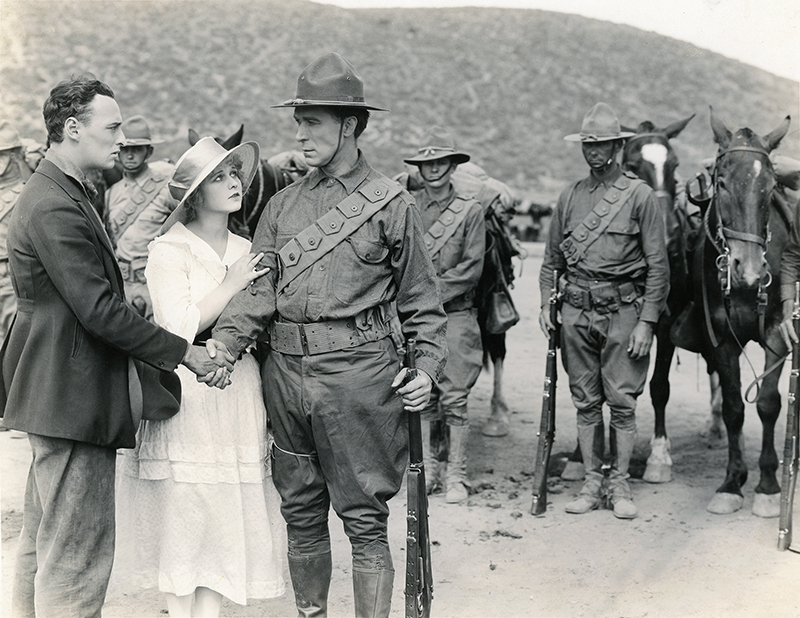"The Border Wireless"
Starring William S. Hart

Click image to enlarge
| Download archival scan
Wanda Hawley's little heart is beating so loudly it would drown out the soundtrack if there were such a thing in this silent picture from 1918, "The Border Wireless," starring William S. Hart. We couldn't hear it anyway, because the film no longer exists. We have to content ourselves with ephemera such as this original 8x10 publicity photograph to know what the picture looked like. It was a somewhat offbeat role for Hart, despite the typical bad-guy-turns-good trope. Hart's character is a bandit on the run from the law when he enlists in the Army under a false identity and discovers a nest of German spies near the Mexican border who are communicating by wireless (radio) with the Kaiser's headquarters in Berlin as they plot to kill Gen. John J. Pershing and his staff. The unlikely hero foils the plot, gets a pardon and wins the girl (who has little to do with the storyline, but there's always a girl).
About "The Border Wireless." From Koszarski (1980:98): Produced by William S. Hart Productions; advertised as "supervised by Thomas H. Ince;" distributed by Paramount-Artcraft; released October 8, 1918; © September 10, 1918; five reels (4353 feet). Directed by William S. Hart; screenplay by C. Gardner Sullivan from a story by Howard E. Morton; photographed by Joe August; art director, Thomas A. Brierley; art titles by Irwin J. Martin. CAST: William S. Hart (Steve Ransom); Wanda Hawley (Elsa Miller); Charles Arling (Herman Brandt); James Mason (Carl Miller); E. von Ritzen (Frederick Schloss); Bertholde Sprotte (Von Helm); Marcia Manon (Esther Meier). SYNOPSIS: German agents have put up a wireless at Magdalene mine, where they send code messages into Mexico and thence to Berlin. Brandt, one of the agents, suspects Steve Ransom, a cow-puncher, of too great loyalty to the United States and investigates his record. He finds that Steve is a fugitive from justice and wires to the army post where Steve has gone to enlist. Steve overhears the officer taking the message and escapes. He wishes to say goodbye to his sweetheart before leaving the community and makes a daring try. On the way he finds a messenger who has been thrown from his horse and who while in a semi-conscious state overheard Brandt and his conspirators plotting to send a wireless to sink the boat on which General Pershing and his staff are sailing. With the girl who has discovered the messenger's riderless horse and come to his rescue, Steve goes to the Magdalene mine and holds the German spies at bay until relief comes from the army post. He also wins the girl. [Exhibitor's Trade Review, September 28, 1918] REVIEWS: Timely subject matter of a sensational nature and a new characterization by Hart will carry this picture over to success. Still an outlaw, a price on his head for manslaughter, Hart is grim-visaged only at intense moments. He actually smiles and conducts himself during courtship with a rare sense of humor, instead of taking himself too seriously. ... [Louis Reeves Harrison, Moving Picture World, October 12, 1918.] William S. Hart needs a change of subjects. The sameness of his pictures is beginning to tell. ... Why does not Hart turn his faithful horse out to pasture for an indefinite period, hang up his sombrero and six-shooters, put on store clothes — even a dress suit — and go in for another type of drama? ... So fine an actor, so forceful a personality would carry his following with him even though stripped of all his familiar trappings. ... Largely because of Hart's great success in Western pictures, that kind of photoplay has been done almost to death. He has had a host of imitators ... there have been so many features of this kind that they are beginning to pall. Only one of exceptional merit now gives the old thrill, and they are few and far between. [S. M. Weller, New York Review, August 1918.]
LW3628: 9600 dpi jpeg from original photograph purchased 2019 by Leon Worden.
|





